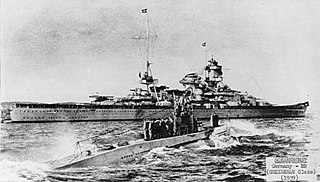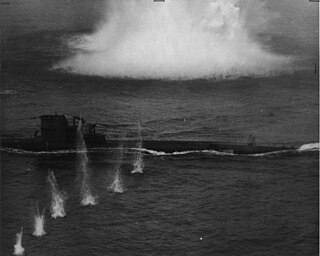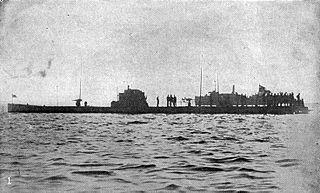
German submarine U-552 was a Type VIIC U-boat built for Nazi Germany's Kriegsmarine for service during World War II. She was laid down on 1 December 1939 at Blohm & Voss in Hamburg as yard number 528, launched on 14 September 1940, and went into service on 4 December 1940. U-552 was nicknamed the Roter Teufel after her mascot of a grinning devil, which was painted on the conning tower. She was one of the more successful of her class, operating for over three years of continual service and sinking or damaging 35 Allied ships with 164,276 GRT and 1,190 tons sunk and 26,910 GRT damaged. She was a member of 21 wolf packs.

USS Reuben James (DD-245) was a four-funnel Clemson-class destroyer made after World War I that was the first US Navy ship named for Boatswain's Mate Reuben James, who distinguished himself fighting in the First Barbary War, and was the first sunk by hostile action in the European Theater of World War II. Reuben James was laid down on 2 April 1919 by the New York Shipbuilding Corporation of Camden, New Jersey, launched on 4 October 1919, and commissioned on 24 September 1920. The destroyer was sunk by a torpedo attack from German submarine U-552 near Iceland on 31 October 1941, before the United States had officially joined the war.

The USS Panay incident on December 12, 1937, was a Japanese bombing attack on the U.S. Navy river gunboat Panay and three Standard Oil Company tankers on the Yangtze River. They strafed survivors in the water. The boats were rescuing U.S. and Chinese civilians fleeing from Japanese invaders attacking Nanking, China. Japan and the United States were not at war at the time. Public outrage was loud in the U.S., but both sides were conciliatory and quickly settled the dispute. The Japanese claimed that they did not see the U.S. flags painted on the deck of the gunboat. Tokyo officially apologized, and paid a cash indemnity. The settlement mollified some of the U.S. anger, and newspapers called the matter closed.
USS Gudgeon (SS-211) was the first American submarine to sink an enemy warship in World War II. She was the last of the long-range Tambor-class vessels commissioned for the United States Navy in the years before the country entered World War II. Gudgeon scored 14 confirmed kills, placing her 15th on the honor roll of American submarines. She was declared overdue, presumed lost with all hands, on 7 June 1944. Of the twelve Tambor-class submarines, only five survived the war.

German submarine U-853 was a Type IXC/40 U-boat of Nazi Germany's Kriegsmarine during World War II. Her keel was laid down on 21 August 1942 by DeSchiMAG AG Weser of Bremen. She was commissioned on 25 June 1943 with Kapitänleutnant Helmut Sommer in command. U-853 saw action during the Battle of the Atlantic in World War II. She conducted three patrols, sinking two ships totalling 5,353 GRT and 430 tons.

German submarine U-47 was a Type VIIB U-boat of Nazi Germany's Kriegsmarine during World War II. She was laid down on 25 February 1937 at Friedrich Krupp Germaniawerft in Kiel as yard number 582 and went into service on 17 December 1938 under the command of Günther Prien.

The second USS Panay (PR–5) of the United States Navy was a Panay-class river gunboat that served on the Yangtze Patrol in China until sunk by Japanese aircraft on 12 December 1937 on the Yangtze River.

USS Niblack (DD-424), a Gleaves-class destroyer, is the only ship of the United States Navy to be named for Albert Parker Niblack. Niblack became the Director of Naval Intelligence 1 March 1919, and Naval Attache in London 6 August 1920. As vice admiral, he commanded U.S. Naval Forces in European waters from 15 January 1921 to 17 June 1922.

German submarine U-134 was a Type VIIC U-boat of Nazi Germany's Kriegsmarine during World War II. She was laid down on 6 September 1940 by Bremer Vulkan in Bremen-Vegesack as yard number 13 and commissioned on 26 July 1941. In seven patrols, U-134 sank three ships for a total of 12,147 gross register tons (GRT).

German submarine U-38 was a Type IXA U-boat of Nazi Germany's Kriegsmarine that operated during World War II.
German submarine U-30 was a Type VIIA U-boat of Nazi Germany's Kriegsmarine that served during World War II. She was ordered in April 1935 in violation of the Treaty of Versailles, which prevented the construction and commissioning of any U-boats for the German navy, and as part of the German naval rearmament program known as Plan Z. She sank the liner SS Athenia (1922) on 3 September 1939, under the command of Fritz-Julius Lemp. She was retired from front-line service in September 1940 after undertaking eight war patrols, having sunk 17 vessels and damaging two others. U-30 then served in a training role until the end of the war when she was scuttled. She was later raised and broken up for scrap in 1948.

SM U-53 was one of the six Type U 51 U-boats of the Imperial German Navy during the First World War.
SS Louise Lykes was a Type C2-F ship built in 1941 at Federal Shipbuilding of Kearny, New Jersey. She sailed for the Lykes Brothers Steamship Company out of New Orleans, Louisiana. On 9 January 1943, she was sunk with all hands in the North Atlantic by German submarine U-384.
Seewolf was the name of three separate wolfpacks of German U-boats that operated during the Battle of the Atlantic in World War II.

German submarine U-52 was a type VIIB U-boat of Nazi Germany's Kriegsmarine during World War II. She was initially ordered on 15 May 1937, in violation of the terms of the Treaty of Versailles, and laid down on 9 March 1938, at the yards of Friedrich Krupp Germaniawerft AG in Kiel as yard number 587. Launched on 21 December 1938, she was commissioned on 4 February 1939, under the command of Kapitänleutnant (Kptlt.) Wolfgang Barten.
The Torpedo Alley, or Torpedo Junction, off North Carolina, is one of the graveyards of the Atlantic Ocean, named for the high number of attacks on Allied shipping by German U-boats in World War II. Almost 400 ships were sunk, mostly during the Second Happy Time in 1942, and over 5,000 people were killed, many of whom were civilians and merchant marines. Torpedo Alley encompassed the area surrounding the Outer Banks, including Cape Lookout and Cape Hatteras.
MS Sama was a Norwegian motor merchant ship, she was torpedoed and sunk by a German submarine during World War II.
Hell Below is a TV series on The Smithsonian Channel produced by Parallax Film Productions Inc. The series is narrated by Canadian voice-over artist Mark Oliver, charting the stealth game of subsea warfare and the narrative from contact to attack of the greatest submarine patrols of World War II. Six initial episodes cover the rise of the Wolfpack to the drive for victory in the Pacific. Expert analysis and stock footage are woven with re-enactments filmed on authentic Second World War era submarines.
SS Robert E. Lee was a steam passenger ship built for the Eastern Steamship Lines in 1924. It was sunk on 30 July 1942 after being torpedoed by the German submarine U-166 on its return to New Orleans.










